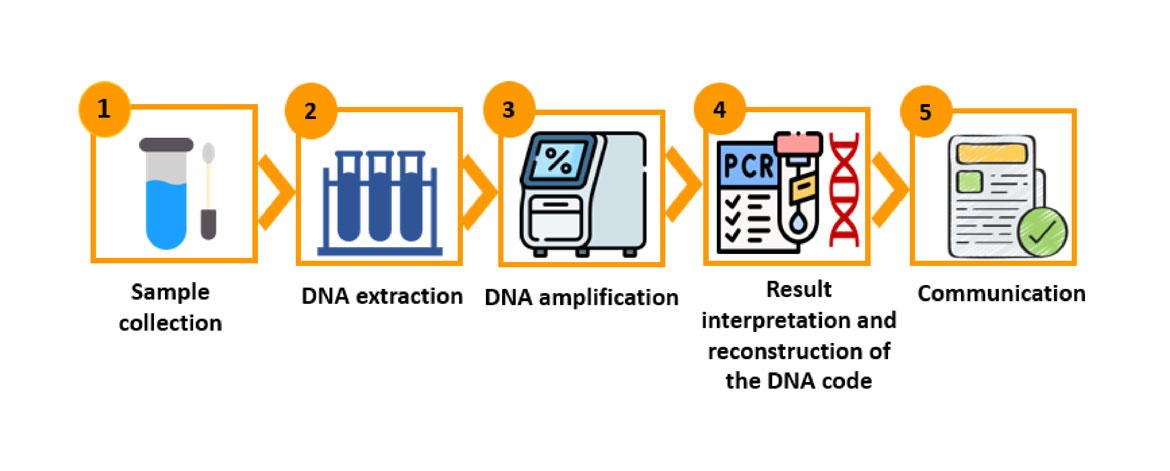Environmental DNA (eDNA)
Learn about the analysis of eDNA, a transformative tool that, along with other methods, can change how we monitor aquatic environments.
What is eDNA?
Environmental DNA (eDNA) is genetic material shed by organisms into their environment. The analysis of eDNA, collected from a sample of water or sediment, allows researchers to identify the organisms present at a location. The analysis of eDNA is an effective, non-invasive, and cost-effective way to detect and track different species, support species monitoring and surveillance programs, and perform overall biodiversity assessments.
How it works
The analysis of eDNA is broadly explained in 5 steps:

- Scientists collect samples from sediment or water that contain genetic material (DNA) left behind by from organisms.
- The collected samples are sent to a lab and passed through a filter to separate the genetic material (DNA) from the sediment or water so that it can be extracted for further analysis.
- Scientists create multiple copies of the extracted DNA using a process called Polymerase Chain Reaction (PCR) amplification. This step makes many copies of DNA (called amplified DNA) so that the DNA found in the samples can be detected, sequenced, and attributed to a specific species with confidence.
- Scientists compare the sequences of eDNA to the known DNA sequences of species stored in online databases. This step helps identify the organisms in the aquatic environment and helps us understand biodiversity within the area.
- Scientists communicate their findings or results in the form of reports, publications, or presentations to advance our understanding of species diversity, presence, distribution, and habitat use.
eDNA uses
Combined with other methods, the analysis of eDNA is an efficient, non-invasive, and cost-effective tool to support sustainable species management measures. Here are some of the ways we are using eDNA:
- Biodiversity monitoring: eDNA can help us monitor species within an environment. We are able to count the number of species within an area to measure its biodiversity – meaning the different kinds of living organisms that exist in a particular place. This approach can help us understand the distribution, diversity, and relative abundance of species within a certain area, as well as their habitat use, making it a powerful tool to inform fisheries management, aquatic environmental monitoring, and conservation efforts
- Invasive species detection: eDNA analysis is an effective tool for early detection of aquatic invasive species. It allows the detection of invasive species before they can be seen, e.g., at their earliest life stages (such as larvae) when they are hard to visually identify, and when abundance is still low. Using eDNA to detect invasive species helps to inform management actions to control invasive species and eDNA methods have already been successfully used in studies of invasive species, such as Asian carp, European Green Crab, and Zebra and Quagga Mussels
- Species mapping: analysis of eDNA helps us discover, identify, and track the distribution of different species, including species that are not commonly found and/or that live in specific habitats (rare species), species that are vulnerable to threats to their survival (at-risk), and species that are difficult to identify (cryptic). Species mapping with eDNA helps us identify and assess the geographic range, distribution, and habitat associated with various species
Our eDNA work
Every day our scientists use eDNA methods to advance our understanding of our aquatic ecosystems. We are actively collaborating with different stakeholders and engaged in ongoing efforts through the Canadian Standards Association and the International eDNA Standardization Task Force (iESTF), to develop standardized protocols for the collection, storage, and analysis of eDNA. The standardization of this method helps improve reliability and comparability of eDNA-based results, as well as facilitate collaboration and data-sharing.
We are also proud that our Gulf Fisheries Centre is an International Standards Organization (ISO) 17025 accredited eDNA testing lab for aquatic invasive species. The accreditation certifies that the results produced in the lab meet international standards for accuracy and reliability.
Related Links
- Date modified: